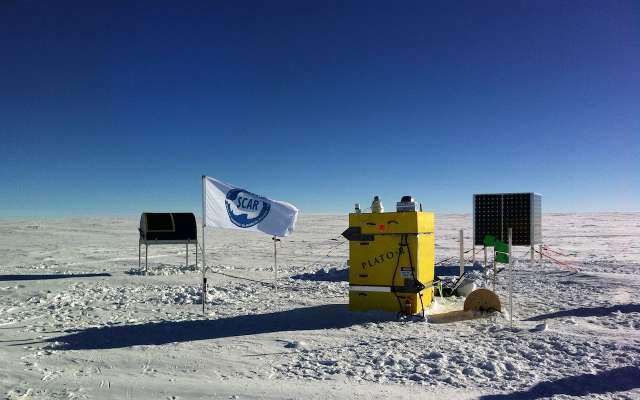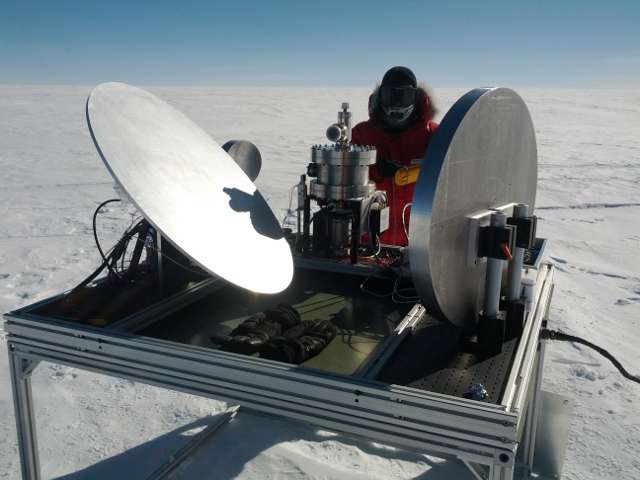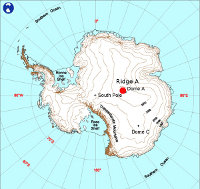Ridge A, Antarctica
Over a decade of site testing in Antarctica has shown that the Antarctic plateau contains exceptional sites for astronomy, with certain atmospheric conditions (e.g., turbulence, water vapour content, infrared emission, and terahertz sky transparency) that are greatly superior to those at existing mid-latitude observatory sites.
Ridge A is 929 km from the South Pole and 159 km from Dome A, the highest summit of the Antarctic plateau. The atmosphere above Ridge A is believed to have the lowest water vapour content of any site on the plateau.
The PLATO-R observatory
PLATO-R, the PLATeau Observatory for Ridge A, is a self-contained automated platform for conducting year-round experiments completely robotically from the Antarctic plateau. It is the result of a scientific collaboration between the University of Arizona and the University of New South Wales.
PLATO-R runs without any human intervention on site. In fact, the closest person is 929 km away and there is no possibility of any maintenance to PLATO-R for 51 weeks of the year. Servicing occurs one week a year during summer. PLATO-R has to generate its own electricity and heat, and is responsible for its own internet connectivity.
PLATO-R was taken to Ridge A by members of the University of Arizona and University of New South Wales, over a three day period beginning on 20 January 2012. PLATO-R is situated at a longitude of 72:42:58E, a latitude of -81:40:24.8S, and an elevation of 4,035m (as measured with the GPS in the PLATO-R supervisor computer). The Mission Time at top right shows how long PLATO-R has been successfully running.
PLATO-R is an evolution of the original PLATO experiment that began operation at the Chinese Kunlun station at Dome A in January 2008. The original PLATO ran continuously for 204 days in 2008, and, following servicing missions in January of each year since, has operated continuously from January 2009 until 2012. A new observatory, PLATO-A, has taken over from PLATO at Dome A.
 PLATO-R at Ridge A, January 2012. The Instrument Module is the yellow box, the HEAT telescope is the black object at left, on stilts. The black object at right is a solar panel array, and consists of eight 195W panels arranged in a cube. On the roof of the Instrument Module you can see various Iridium satellite aerials, webcameras, and an all-sky camera called HRCAM3. The Engine Module, that provides power when the sun is down, is 60 metres away (credit: Craig Kulesa).
PLATO-R at Ridge A, January 2012. The Instrument Module is the yellow box, the HEAT telescope is the black object at left, on stilts. The black object at right is a solar panel array, and consists of eight 195W panels arranged in a cube. On the roof of the Instrument Module you can see various Iridium satellite aerials, webcameras, and an all-sky camera called HRCAM3. The Engine Module, that provides power when the sun is down, is 60 metres away (credit: Craig Kulesa).
Power systems and control
PLATO-R consists of two fibreglass modules, each just small enough to fit in a Twin Otter aircraft, and weighing about 500kg each. The Engine Module contains two Hatz 1B30 diesel engines and 800 litres of AN-8 fuel. The Instrument Module is placed 60m away and contains the computer systems, battery bank, power supplies, and science instruments. Solar panels and the HEAT telescope are external to both modules. The modules are extremely well thermally insulated.
The two modules are linked by a 120VDC cable that distributes up to 3kW of peak electrical power. A CAN (Controller Area Network) bus is used to control the modules. Solar panels provide an additional peak output of 0.9kW of electricity during the summer time, allowing operation entirely on solar power for several months of each year.
The PLATO-R computer system is based on two redundant PC/104 systems (Parvus ISIS/XL), each with an Iridium satellite modem for remote control and capable of transmitting up to 20MB of science data per day. The computers boot from internal flash disks tested for low temperature and high altitude performance. A readonly filesystem is used for the Debian GNU/Linux "Wheezy" operating system to maximise reliability.
Instruments
PLATO-R is an international collaboration, with instruments contributed from the US and Australia.
Please visit the science page for information on the science that PLATO-R will be performing.
 The HEAT telescope with Craig Kulesa at Ridge A in January 2012. Light bounces off the flat primary siderostat mirror, into the 0.62m aperture parabolic mirror at right, then into an ellipsoidal tertiary, before reaching the detector in the cryostat near the middle of the photo (credit: Luke Bycroft).
The HEAT telescope with Craig Kulesa at Ridge A in January 2012. Light bounces off the flat primary siderostat mirror, into the 0.62m aperture parabolic mirror at right, then into an ellipsoidal tertiary, before reaching the detector in the cryostat near the middle of the photo (credit: Luke Bycroft).
Participating institutions in alphabetical order
 |
University of Arizona, USA |
 |
University of New South Wales, Australia |
Funding agencies (in additional to the participants above) in alphabetical order
 |
 |
 |
Logistics supplied by
 |

